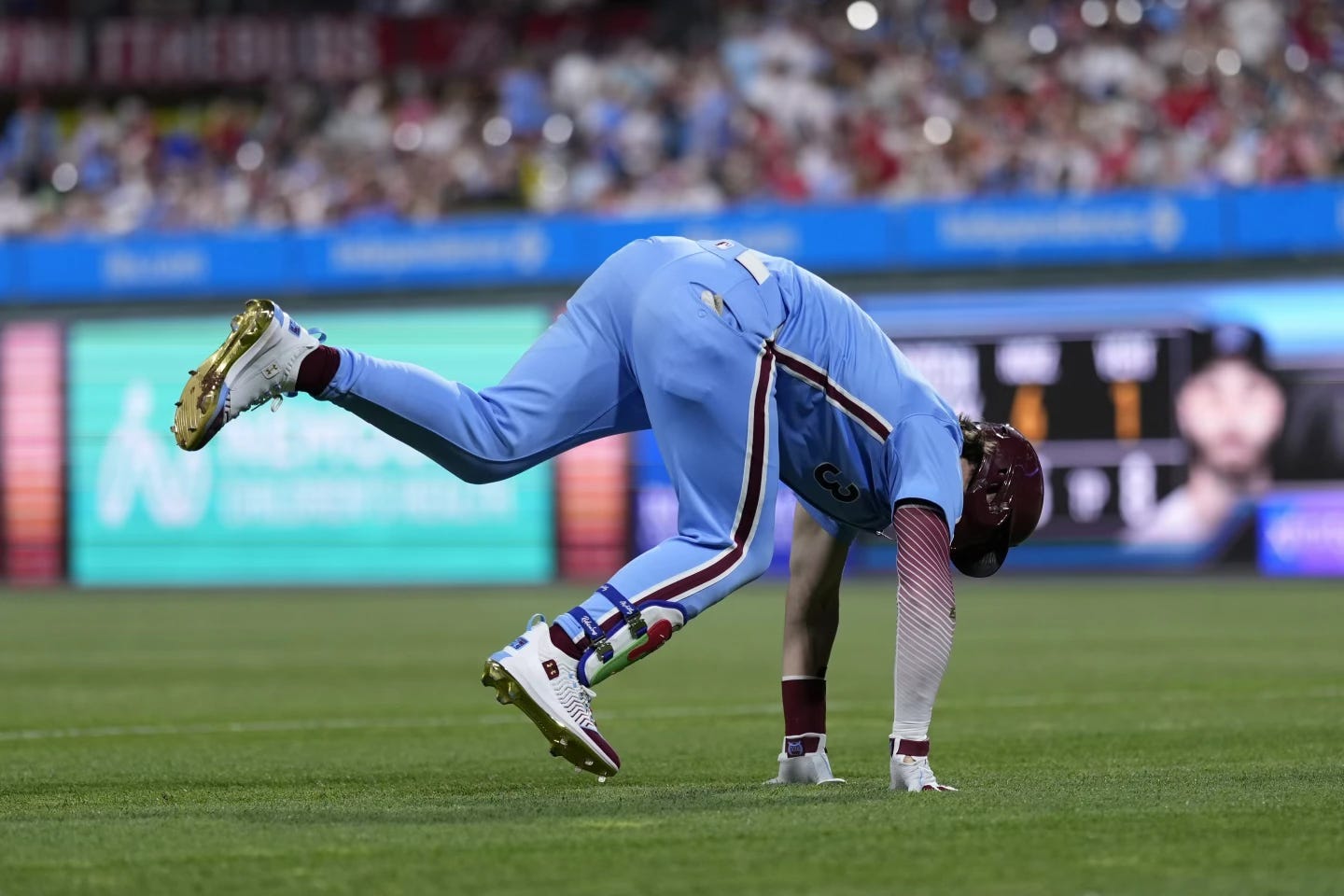The Philadelphia Phillies Reactive Strength Problem: A Limiting Constraint
Lower Body Reactive Strength Injuries: The Number One Limiting Constraint on the Phillies + The Pathway to Solving the Issue

Reactive Strength Injuries: A Real Problem Leading to the Stagnation in Sport
The Phillies, like the NFL, have a reactive strength problem—that is a real limiting constraint on high performance this season. Key players Bryce Harper and Kyle Schwarber have both suffered lower body reactive strength injuries and are now just returning to play. Despite these injuries, the Phillies have a 59-32 record, positioning them as a contender for this season's World Series.
The first concept we discussed here at Absolute is stagnation in sports. The recent reactive strength injuries in MLB and the NFL exemplify our point that stagnation is indeed a sobering reality in the highest levels of competition in modern sports. The antidote to this stagnation is training work—the selection, organization, and execution of which we, as strength practitioners, specialize in. In other words, we, as strength practitioners, are the solution to overcoming these limiting constraints on high performance.
Why We Reframed
We reframed these reactive strength injuries to enable us, as strength practitioners, to take action—specifically by utilizing training to optimally cultivate the biological elements of reactive strength.1 By doing so, we can assert that we are part of the solution to the reactive strength problem, not part of the problem. Unfortunately, some of our colleagues continue to use a non-ecological training paradigm, relentlessly scaling up the athletes' neurology to the point where it can, at any moment, blow up their connective tissue architecture. A recent example of this is the Green Bay Packers' offseason training, where three pectoral ruptures occurred in a training setting.
Reframing → The Training Solution to the Reactive Strength Problem
Reframing these lower body 'muscle strains' as reactive strength injuries allows us, as strength practitioners, to identify the training pathway to resolving this constraint on high performance. The solution lies in addressing the bottom-up biological component of reactive strength.
Harper Hamstring Injury Analysis
If you watch Harper injure the connective tissue architecture of his hamstrings, you’ll notice that his neurology is voluntarily generating normal force output at the highest attainable speed—our definition of speed strength, when the connective tissue yields. This understanding allows us to conclude that his neurology has outpaced his biology. This could happen for several reasons, with the most probable being that, as he is in-season, his connective tissue architecture is scaling down instead of sustaining or increasing.
Understand: Connective tissue is stress-responsive, meaning if we remove or suboptimally execute connective tissue architecture training in-season, the lack of specific stress will result in architecture that is suboptimal in its ability to transmit force. This is exactly what you see in the Harper injury.
We Have to Load Our Way Out of this Problem
In our extensive work with professional athletes who have bottom-up issues with reactive strength, this is not a problem that can be solved with a Theragun or simply rubbing the booboo area of the hamstring (credit to Dr. Andreo Spina for the "rubbing the booboo" joke). We need to load our way out of this issue, and specific soft tissue treatment is a paramount part of solving this puzzle. Connective tissue responds to load and direction, so we need to assess the tissue and apply directional loading that stimulates its development in a way that enables optimal force transmission.
The Strategy for Loading Our Way Out of the Problem
We have simple heuristics in the Absolute Conjugate Strategy that allow strength practitioners to navigate these bottom-up reactive strength injuries. For example, the 2.1 ratio of static to dynamic loading of connective tissue helps us understand the necessary volume of static loading in cases like Harper's once the tissue was cleared for length. This ratio allows us to retrospectively understand that his hamstrings were likely only subjected to lengthening loads and not static loads—non-ecological loading. There is a difference between training statically and dynamically, and if no static work is being done, the connective tissue is not being optimally stimulated for architectural changes.
We use the internal isometric continuum to guide our coaching cues. To bias force accumulation into the connective tissues and stimulate architectural changes, we would instruct Harper to focus on 'holding' rather than 'pressing' when performing isometrics. This continuum recognizes that holding isometrics, or 'HIMA', are more biologically stimulating than pressing isometrics, or 'PIMA'.
Keep reading with a 7-day free trial
Subscribe to Absolute: The Art and Science of Human Performance to keep reading this post and get 7 days of free access to the full post archives.




